What is Life?
Probably the best place to begin our discussion of the Earth’s biogeography is to answer the following question. What is life? While the reply to this question may appear simple, scientists have actually spent considerable time pondering this problem. In fact, many scientists would suggest that we still do not have a clear definitive answer to this question. Part of this problem is related to the existence of viruses and other forms of microscopic things. Some scientists define viruses as very complex organic molecules, while others suggest they are the simplest form of life.
In a recent issue of the journal Science (March 22, 2002), molecular biologist Daniel E. Koshland Jr. was asked to write a special essay where he would set out to define life. In this article, he suggested that something could be considered “alive” if it meets the following seven conditions.
(1). Living things must have a program to make copies of themselves from generation to generation. This program would describe both the parts that make up the organisms and the processes that occur between the various parts. These processes are of course the metabolic reactions that take place in a living thing allowing it to function over time. In most living systems, the program of life is encoded in DNA.
(2). Life adapts and evolves in step with external changes in the environment. This process is directly connected to life’s program through mutation and natural selection. This condition allows life-forms to be optimized for gradual changes in the environment.
(3). Organisms tend to be complex, highly organized, and most importantly have compartmentalized structures. Chemicals found within their bodies are synthesized through metabolic processes into structures that have specific purposes. Cells and their various organelles are examples of such structures. Cells are also the basic functioning unit of life. In multi-cellular organisms, cells are often organized into organs to create higher levels of complexity and function.
(4). Living things have the ability to take energy from their environment and change it from one form to another. This energy is usually used to facilitate their growth and reproduction. We call the process that allows for this facilitation metabolism.
(5). Organisms have regeneration systems that replace parts of themselves that are subject to wear and tear. This regeneration can be partial or it can involve the complete replacement of the organism. Complete replacement is necessary because partial replacements cannot stop the unavoidable decline in the functioning state of the entire living system over time. In other words, all organisms degrade into a final non-functioning state we call death.
(6). Living creatures respond to environmental stimuli through feedback mechanisms. Cues from the environment can cause organisms to react through behavior, metabolism, and physiological change. Further, responses to stimuli generally act to increase a creature’s chance for day-to-day survival.
(7). Organisms are able to maintain numerous metabolic reactions even in a single instance in time. Living things also keep each of these reactions separated from each other.
Origin of Life
The Sun and its planets formed between 5 and 4.6 billion years ago as matter in our solar system began to coalesce because of gravity. By about 3.9 billion years ago, the Earth had an atmosphere that contained the right mix of hydrogen, oxygen, carbon, and nitrogen to allow for the creation of life. Scientists believe that the energy from heat, lightning, or radioactive elements caused the formation of complex proteins and nucleic acids into strands of replicating genetic code. These molecules then organized and evolved to form the first simple forms of life. At 3.8 billion years ago, conditions became right for the fossilization of the Earth's early cellular life forms. These fossilized cells resemble present day cyanobacteria. Such cells are known as prokaryotes. Prokaryote cells are very simple, containing few specialized cellular structures and their DNA is not surrounded by a membranous envelope. The more complex cells of animals and plants, known as eukaryotes, first showed up about 2.1 billion year ago. Eukaryotes have a membrane-bound nucleus and many specialized structures located within their cell boundary. By 680 million years ago, eukaryotic cells were beginning to organize themselves into multicellular organisms. Starting at about 570 million years ago an enormous diversification of multicellular life occurred known as the Cambrian explosion. During this period all but one modern phylum of animal life made its first appearance on the Earth. Figure 9a-1 describes the approximate time of origin of the Earth' s major groups of plants and animals.
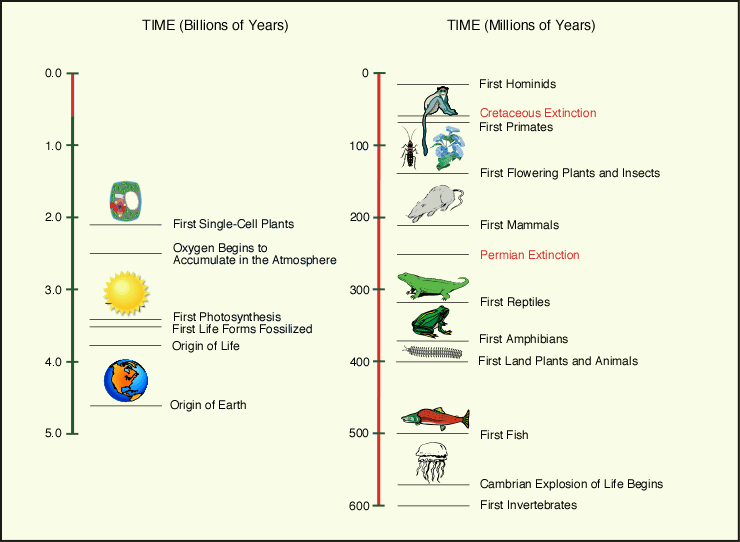
| Figure 9a-1: Important events in the evolution of life. Dates for many of the events shown are based on fossil evidence. |

| Figure 9a-2: This fish fossil from Wapiti Lake in British Columbia, Canada was alive during the geologic period known as the Triassic (208-245 million yrs BP). Fish first appear on our planet during the Ordovician Period about 500 million years ago. |
Domains and Kingdoms of Life
Based on the criteria just described, scientists currently recognize three major domains of living things: Archaea, Bacteria, and Eukaryota. Archaea are a group of recently discovered organisms that are adapted to live in extremely hostile habitats. Habitats like thermal volcanic vents, saline pools, and hotsprings. These single-celled organisms are quite similar in appearance to bacteria. However, molecular studies have shown that this group of organisms is biochemically and genetically very different from bacteria.
Bacteria are simple single-celled organisms that generally lack chlorophyll (an exception is cyanobacteria). Bacteria generally obtain energy for survival through the breakdown of organic matter through fermentation and respiration. Any organism that relies on living or previously living organic matter for their food is called a heterotroph. Bacteria such as cyanobacteria and those belonging to the genus Rhizobium play an important role in the fixing of atmospheric nitrogen. Without these organisms, most ecosystems would be in short supply of nitrogen. Nitrogen is an essential nutrient used by both plants and animals for growth. Bacteria also have an important role in soils decomposing organic matter. The process of decomposition breaks organic matter back into essential chemical elements. Once converted, these recycled nutrients can be used again for the growth and metabolism of organisms.
Eukaryota are organisms that have a eukaryote cell type. This group of life includes the four primary kingdoms: Protista, Fungi, Plantae (plants) and Animalia (animals). A kingdom is a classification category, the second broadest after domain. Kingdom Protista is made up of single celled organisms and some of their simple multi-cellular close relatives. Some examples of unicellular protists include dinoflagellates, amoebas, paramecium, diatoms, and volvox. Slime molds, brown algae, red algae, and green algae like Ulva (sea lettuce) are typical examples of multi-cellular forms of protists (Figure 9a-3).
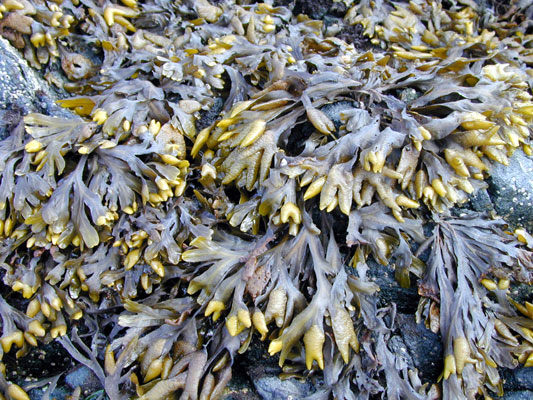
| Figure 9a-3: Protists can also be multi-cellular. Example of multi-cellular protists is shown: Brown Algae - Fucus sp. |
Researchers estimate that about 1.5 million different species of fungi exist on our planet (Figure 9a-4). Most of these life-forms are multi-cellular. Biologists once grouped fungi with plants. However, investigations of this life-form indicate that fungi are quite different from other eukaryotes in terms of feeding strategies, physiological organization, and reproduction and growth. Many species of fungi are heterotrophic decomposers or they live in symbiosis with another species. Symbiosis is biological interaction where two different species are in direct contact with each other. This relationship is also necessary for the survival of one or both of the participating species. Lichens are good examples of this type of biotic relationship. Lichens involve the symbiotic relationship between a fungus and a photosynthetic alga (Figure 9a-5).
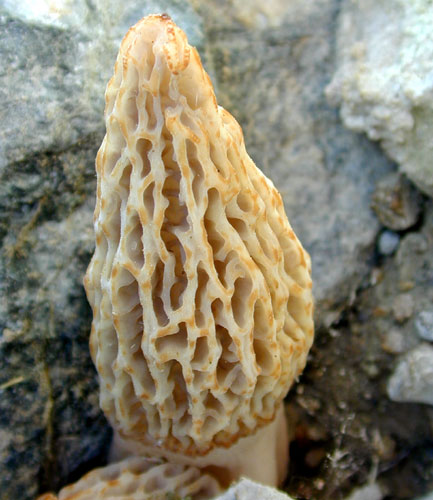
| Figure 9a-4: Fungi have a eukaryotic cell type and most are multi-cellular like the mushroom species shown above. Fungi absorb the nutrients they require for growth and reproduction from their surrounding environment. To help with this absorption, fungi release enzymes that decompose complex organic molecules into simpler compounds. |
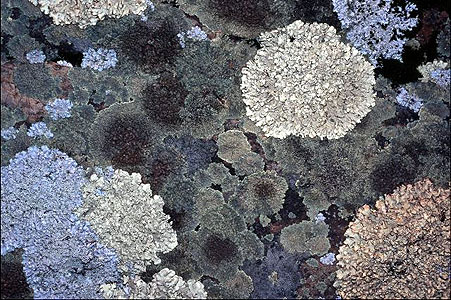
| Figure 9a-5: Lichens are an organism formed by the symbiotic association between a photosynthetic green alga and a fungus. In this relationship, the algae supplies the fungus with sugar molecules produced via photosynthesis. The fungus provides the alga with all the conditions it needs to grow protected from the more severe outside environment. |
The kingdom Plantae is composed of multi-cellular organisms that can convert inorganic elements, with the help of the Sun’s energy, into organic compounds. In plants, this process is carried out by a chemical reaction known as photosynthesis. Any life form that can carry out photosynthesis is considered to be an autotroph. An autotroph is any organism that can fix organic molecules from inorganic elements with the help of an external energy source. Autotrophs also consume some of organic compounds they create to fuel their metabolism and growth.
Plantae includes all land plants, including mosses, ferns, conifers, and flowering plants (Figure 9a-6). Diversity in this kingdom is quite large with more than 250,000 species. Two other important traits associated with plants are cell walls made of cellulose and a large central cellular vacuole. Cellulose is an extremely strong organic material allowing plants to build tall structures like stems and tree trunks. The other distinguishing feature of plants, the large central vacuole, is used to store water reserves, essential chemicals for growth and metabolism, waste products, poisons, or flower pigments.

| Figure 9a-6: The dominant types of plants include the mosses, the ferns, the horsetails, the gymnosperms (pines, spruce, fir, larch, junipers, redwoods, and cedars), the angiosperms (flowering plants), and the ginkgoes. Plants have an extremely important role in terrestrial habitats. Through photosynthesis they create most of the organic molecules that will cycle through the food webs of most ecosystems. Thus, plants ultimately allow many heterotrophic species of organisms to survive. Image shows the flower of a typical angiosperm species. |
Animals are multi-cellular organisms that have a eukaryotic cell type (Figure 9a-7). For food, species in the kingdom Animalia must ingest already produced organic molecules. Unlike plants, animals are heterotrophs and therefore do not have the ability to create their own nourishment from inorganic compounds. Animals also differ from other forms of life by having two unique tissue types: nervous tissue and muscle tissue. Finally, most animals produce their offspring through sexual reproduction.
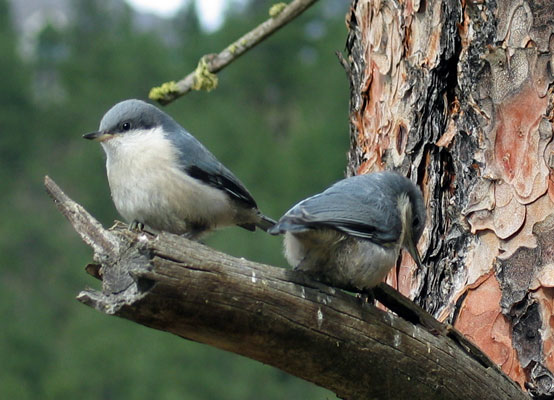
| Figure 9a-7: Birds are an example of an organism that belongs to the kingdom Animalia. |